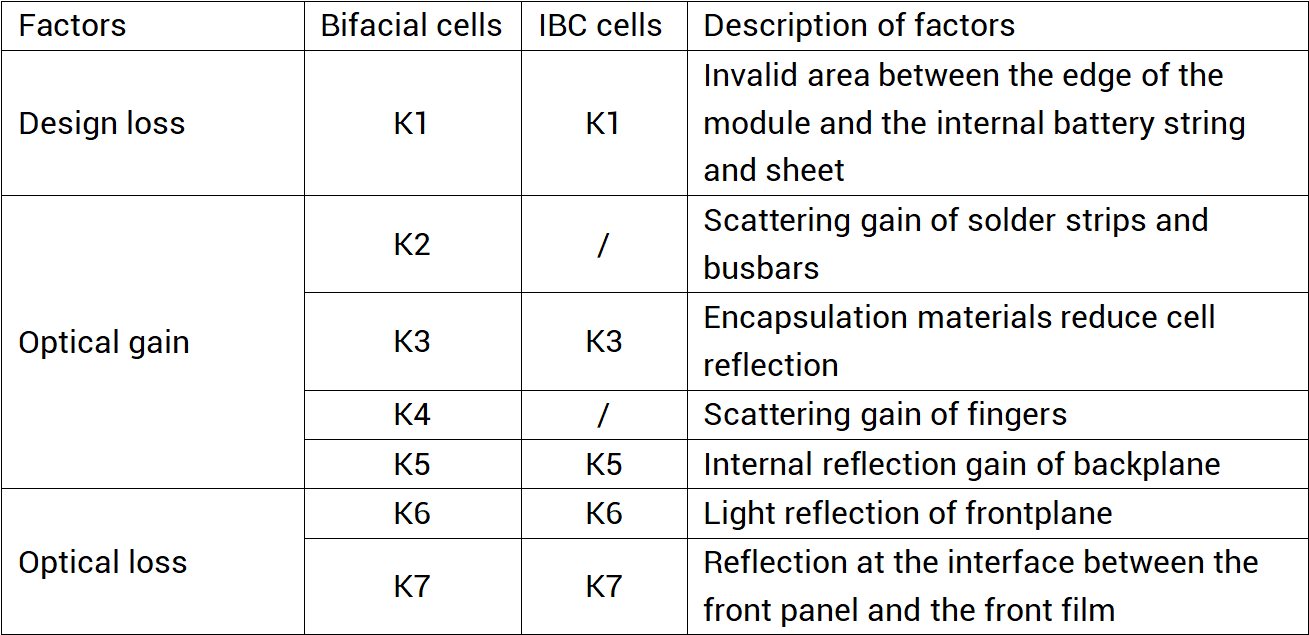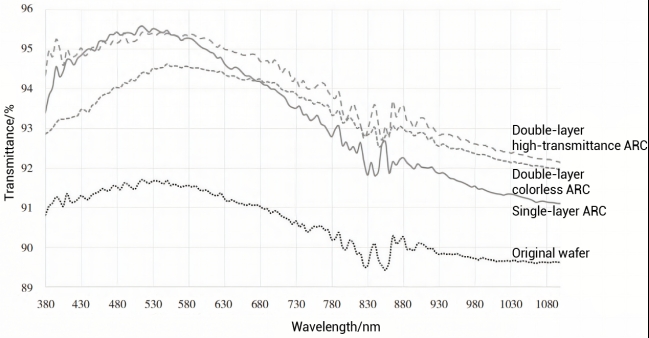The percentage of PV module output power to the total power of the cell (CTM) is an important parameter to measure the degree of power loss in module packaging. The promotion and application of high-efficiency cells such as PERC, TOPCon, HJT and XBC cells have made new packaging materials and processes a research focus.
Packaging loss analysis

CTM influencing factors of different modules
Technologies to improve the CTM of modules include high-transmittance glass and adhesive film, high-reflectivity backplane, round or special-shaped solder strips, multi-busbar MBB interconnection, gap film, negative spacing interconnection, zero spacing interconnection, and shingling process.
CTM influencing factors are divided into four parts: design loss, optical gain, optical loss, and electrical loss.
Analysis and comparison of factors affecting CTM

Factors affecting CTM of bifacial modules
CTM is an important parameter to measure the degree of power loss in module packaging. The higher its value, the lower the power loss in module packaging.
The CTM of bifacial cell modules is affected by many factors, including design, optical gain and loss, electrical loss, etc. The CTM value of the module can be effectively improved by improving the design, selecting high-transmittance materials, optimizing the layout of solder strips and fingers, and improving the matching degree of cells and cell strings.

Factors affecting CTM of BC modules
The CTM of BC cell modules is affected by factors such as design, optical gain and loss, and electrical loss. Compared with bifacial cell modules, BC cell modules lack the light scattering gain of the front solder strip and fine grid lines, which requires special consideration in packaging materials and processes to compensate for the lack of optical gain and reduce packaging losses. The CTM value of BC cell modules can be effectively improved by optimizing packaging materials, improving the matching degree of cells and cell strings, and reducing resistance losses.
BC module packaging loss
The impact of glass

Comparison of different ARC glasses
The use of double-layer high-transparency ARC-coated glass can significantly improve the light transmittance, module power and CTM of photovoltaic modules, thereby reducing packaging losses and improving the overall performance of the module.
Although the light transmittance of double-layer colorless ARC-coated glass is slightly lower than that of double-layer high-transmittance ARC-coated glass, its CTM is still higher than that of single-layer ARC glass, indicating that it also has certain advantages in improving module performance.
Single-layer ARC glass has the worst performance in terms of light transmittance, module power and CTM, and has the largest packaging loss.

Photovoltaic glass transmittance curve
The transmittance of the three types of glass first decreases and then increases with the increase of wavelength, which is related to the glass's ability to transmit light of different wavelengths.
In the wavelength range of 380nm to 480nm, the transmittance of double-layer high-transmittance ARC glass is slightly lower than that of double-layer colorless ARC glass, but still higher than that of single-layer ARC glass.
In the wavelength range of 480nm to 780nm, the transmittance of double-layer high-transmittance ARC glass gradually increases and remains the highest in this range.
In the wavelength range of 780nm to 1100nm, the transmittance of double-layer high-transmittance ARC glass continues to be higher than the other two types of glass.
Photovoltaic glass with high transmittance helps more light energy reach the cell, thereby improving the photoelectric conversion efficiency of photovoltaic modules. Due to its excellent light transmittance, double-layer high-transmittance ARC glass can bring higher module power and CTM value and reduce packaging loss.
The influence of packaging film on BC solar cell module CTM

In the 290nm to 380nm band, the transmittance of POE film is slightly higher than that of EPE film.
In the 380nm to 1100nm band, the transmittance of EPE film is about 0.6% higher than that of POE.

Comparison of different packaging films
For BC cells with 23.7% efficiency, the CTM of the module using EPE film is 0.18% higher than that using POE film.
For BC cells with 24.0% efficiency, the CTM of the module using EPE film is 0.26% higher than that using POE film.
The power of the module encapsulated with EPE film is slightly higher because the EPE film is a 3-layer structure with EVA used in the upper and lower layers, and the transmittance of EVA is about 1% higher than that of POE.
Due to its high transmittance and good performance, EPE film may be more suitable for high-efficiency solar cell modules requiring high CTM values. For BC solar cell modules, choosing a film with higher transmittance can increase the CTM value of the module, thereby reducing packaging losses and improving the overall performance of the module.
The influence of backsheet on CTM of BC modules

Comparison of the spacing between different backplanes and cells
The impact of the backplane on CTM: The gain of the backplane on the CTM of the module is mainly caused by the reflectivity of the inner surface of the backplane. The larger the gap, the more reflected light can be reused, and the greater the module power and CTM gain.
Comparison of the spacing between different backplanes and cells: The difference in spacing between backplanes and cells has a significant impact on module CTM. As the gap increases, the module power and CTM value also increase.
High reflectivity backsheets can significantly increase the CTM value of a module, especially in all-black modules. For BC modules, choosing a high reflectivity backsheet can increase the CTM value of the module, thereby reducing packaging loss and improving the overall performance of the module.
The influence of welding ribbon on CTM of BC module

Comparison of different busbar BC modules
Due to the lack of light scattering gain from the front solder ribbon and fingers, the CTM loss of BC cells is significantly greater than the reduction in shading loss.
When the cell efficiency is the same, the power of 18BB is about 1W~2W higher than that of 12BB cell modules. Increasing the number of BC cell main grid lines and shortening the current transmission distance can reduce electrical losses and improve module CTM.
For BC modules, increasing the number of busbars is an effective way to improve CTM, although they do not benefit from the light scattering of the front solder ribbon like bifacial cells.
The impact of cell mismatch on BC module CTM

Power impact of BC cell mismatch
With the application of cells with G1 specifications and above, half-slice cell welding technology is used in component manufacturing, and the circuit connection changes from full series connection of whole cells to "series-parallel-series" method of half-cell cells. This results in an increase in the number of cells and cell strings, increasing the probability of mismatch.Cell mismatch can significantly affect a module's power output, as efficiency differences between different cells can cause current mismatches, affecting overall performance. Cell mismatch is an important factor affecting BC module CTM. The performance and reliability of the module can be significantly improved through fine efficiency binning and cell matching.

Power comparison of bad BC modules
Workmanship defects, especially welding quality, have a significant impact on module performance. Poor welding may cause a significant decrease in module CTM, which is reflected in the decrease in the output parameters FF (fill factor), Vpmax (maximum power voltage) and Ipmax (maximum power current). Process defects, especially welding-related defects, have a significant negative impact on the CTM of BC modules. By improving the welding process and strengthening quality control, the performance and reliability of the module can be significantly improved.
By using high-transmittance photovoltaic glass, optimized encapsulation film and high-reflectivity backsheet, combined with fine cell sorting and advanced welding technology, BC module's photoelectric conversion efficiency and power output have been significantly improved.